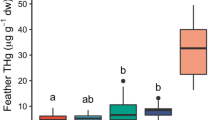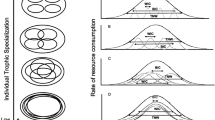Abstract
Feeding strategies can affect the balance between the production of reactive oxygen species and antioxidant defences (i.e. oxidative status). This is ecologically relevant, as variation in oxidative status can in turn strongly affect fitness. However, how animals regulate their oxidative status through their feeding behaviour under natural conditions remains poorly understood. Thus, relating the isotopic values of free-ranging animals to their oxidative status may prove useful. Here, we considered three colonies of gentoo penguins (Pygoscelis papua) in which we measured (1) δ13C and δ15N values, and (2) antioxidant defences and oxidative damage. We found that colonies with the highest δ13C and δ15N values also had the highest levels of antioxidant defences and oxidative damage, resulting in positive relationships between isotopic values and markers of oxidative status. As a result, colony segregation in terms of isotopic values was reflected by segregation in terms of oxidative markers (although more markedly for oxidative damage than for antioxidant defences). Interestingly, variation in the estimated contribution of krill in the diet of penguins followed an opposite pattern to that observed for markers of oxidative status, providing evidence that inter-population differences in terms of foraging strategies can result in inter-population differences in terms of oxidative status. More studies examining simultaneously oxidative status, isotopic signature, foraging behaviour and food allocation between parents and young are, however, needed to understand better the interplay between the foraging strategies adopted by animals in their natural habitat and their oxidative status.




Similar content being viewed by others
References
Atkinson A, Siegel V, Pakhomov E, Rothery P (2004) Long-term decline in krill stock and increase in salps within the Southern Ocean. Nature 432:100–103. doi:10.1038/nature02950.1
Barbosa A, Palacios MJ, Negro JJ, Cuervo JJ (2013) Plasma carotenoid depletion during fasting in moulting penguins. J Ornithol 154:559–562. doi:10.1007/s10336-012-0918-z
Barquete V, Strauss V, Ryan PG (2013) Stable isotope turnover in blood and claws: a case study in captive African penguins. J Exp Mar Bio Ecol 448:121–127. doi:10.1016/j.jembe.2013.06.021
Beaulieu M, Costantini D (2014) Biomarkers of oxidative status: missing tools in conservation physiology. Conserv Physiol 2: cou14. doi:10.1093/conphys/cou014
Beaulieu M, Reichert S, Le Maho Y et al (2011) Oxidative status and telomere length in a long-lived bird facing a costly reproductive event. Funct Ecol 25:577–585. doi:10.1111/j.1365-2435.2010.01825.x
Beaulieu M, Ropert-Coudert Y, Le Maho Y et al (2010) Foraging in an oxidative environment: relationship between δ13C values and oxidative status in Adélie penguins. Proc R Soc Lond B 277:1087–1092. doi:10.1098/rspb.2009.1881
Beaulieu M, Schaefer HM (2013) Rethinking the role of dietary antioxidants through the lens of self-medication. Anim Behav 86:17–24. doi:10.1016/j.anbehav.2013.05.022
Beaulieu M, Sockman KW (2014) Comparison of optimal foraging versus life-history decisions during nestling care in Lincoln’s sparrows Melospiza lincolnii through stable isotope analysis. Ibis 156:424–432
Beaulieu M, Thierry A-M, González-Acuña D, Polito MJ (2013) Integrating oxidative ecology into conservation physiology. Conserv Physiol. doi:10.1093/conphys/cot004
Benito MM, González-Solís J, Becker PH (2011) Carotenoid supplementation and sex-specific trade-offs between colouration and condition in common tern chicks. J Comp Physiol B 181:539–549. doi:10.1007/s00360-010-0537-z
Bize PB, Devevey G, Monaghan P et al (2008) Fecundity and survival in relation to resistance to oxidative stress in a free-living bird. Ecology 89:2584–2593
Carravieri A, Bustamante P, Churlaud C, Cherel Y (2013) Penguins as bioindicators of mercury contamination in the Southern Ocean: birds from the Kerguelen Islands as a case study. Sci Total Environ 455:141–148
Catoni C, Peters A, Schaefer HM (2008) Life history trade-offs are influenced by the diversity, availability and interactions of dietary antioxidants. Anim Behav 76:1107–1119. doi:10.1016/j.anbehav.2008.05.027
Celis J, Jara S, González-Acuña D et al (2012) A preliminary study of trace metals and porphyrins in excreta of Gentoo penguins (Pygoscelis papua) at two locations of the Antarctic Peninsula. Arch Med Vet 44:311–316
Cherel Y (2008) Isotopic niches of emperor and Adélie penguins in Adélie Land, Antarctica. Mar Biol 154:813–821. doi:10.1007/s00227-008-0974-3
Cherel Y, Hobson KA, Bailleul F, Groscolas R (2005) Nutrition, physiology, and stable isotopes: new information from fasting and molting penguins. Ecology 86:2881–2888
Costantini D (2008) Oxidative stress in ecology and evolution: lessons from avian studies. Ecol Lett 11:1238–1251. doi:10.1111/j.1461-0248.2008.01246.x
Costantini D, Møller AP (2008) Carotenoids are minor antioxidants for birds. Funct Ecol 22:367–370. doi:10.1111/j.1365-2435.2007.01366.x
Costantini D, Dell’Ariccia G, Lipp H-P (2008) Long flights and age affect oxidative status of homing pigeons (Columba livia). J Exp Biol 4:377–381. doi:10.1242/jeb.012856
France RL (1995) Carbon-13 enrichment in benthic compared to planktonic algae: foodweb implications. Mar Ecol Prog Ser 124:307–312
Freeman-Gallant CR, Amidon J, Berdy B et al (2011) Oxidative damage to DNA related to survivorship and carotenoid-based sexual ornamentation in the common yellow throat. Biol Lett 7:429–432. doi:10.1098/rsbl.2010.1186
García-Tarrasón M, Sanpera C, Jover L, Costantini D (2014) Levels of antioxidants in breeding female Audouin’s gulls and their deposition in eggs across different environments. J Exp Mar Biol Ecol 453:116–122. doi:10.1016/j.jembe.2014.01.012
Geiger S, Le Maho Y, Kaufmann M et al (2012) Of the importance of metabolic phases in the understanding of oxidative stress in prolonged fasting and refeeding. Physiol Biochem Zool 85:1–8. doi:10.1086/666364
Gilmour M (2011) Physiological ecology and reproductive effort in a migratory seabird. Master’s thesis, Bucknell University, Lewisburg
Helfenstein F, Losdat S, Møller AP et al (2010) Sperm of colourful males are better protected against oxidative stress. Ecol Lett 13:213–222. doi:10.1111/j.1461-0248.2009.01419.x
Hipfner JM, Dale J, McGraw KJ (2010) Yolk carotenoids and stable isotopes reveal links among environment, foraging behavior and seabird breeding success. Oecologia 163:351–360. doi:10.1007/s00442-010-1618-0
Jackson AL, Inger R, Parnell AC, Bearhop S (2011) Comparing isotopic niche widths among and within communities: SIBER—stable isotope Bayesian ellipses in R. J Anim Ecol 80:595–602. doi:10.1111/j.1365-2656.2011.01806.x
Jerez S, Motas M, José M et al (2011) Concentration of trace elements in feathers of three Antarctic penguins: geographical and interspecific differences. Environ Pollut 159:2412–2419. doi:10.1016/j.envpol.2011.06.036
Koivula MJ, Eeva T (2010) Metal-related oxidative stress in birds. Environ Pollut 158:2359–2370. doi:10.1016/j.envpol.2010.03.013
Lescroël A, Bost C (2005) Foraging under contrasting oceanographic conditions: the gentoo penguin at Kerguelen Archipelago. Mar Ecol Prog Ser 302:245–261
Losdat S, Helfenstein F, Blount JD et al (2013) Nestling erythrocyte resistance to oxidative stress predicts fledging success but not local recruitment in a wild bird. Biol Lett 9:20120888. doi:10.1098/rsbl.2012.0888
Miller AK, Trivelpiece WZ (2008) Chinstrap penguins alter foraging and diving behavior in response to the size of their principle prey, Antarctic krill. Mar Biol 154:201–208. doi:10.1007/s00227-008-0909-z
Miller AK, Kappes Ma, Trivelpiece SG, Trivelpiece WZ (2010) Foraging-niche separation of breeding gentoo and chinstrap penguins, South Shetland Islands, Antarctica. Condor 112:683–695. doi:10.1525/cond.2010.090221
Monaghan P, Metcalfe NB, Torres R (2009) Oxidative stress as a mediator of life history trade-offs: mechanisms, measurements and interpretation. Ecol Lett 12:75–92. doi:10.1111/j.1461-0248.2008.01258.x
Munshi-South AJ, Wilkinson GS (2006) Diet influences life span in parrots (Psittaciformes). Auk 123:108–118
Noguera JC, Kim S-Y, Velando A (2012) Pre-fledgling oxidative damage predicts recruitment in a long-lived bird. Biol Lett 8:61–63. doi:10.1098/rsbl.2011.0756
Parnell AC, Inger R, Bearhop S, Jackson AL (2010) Source partitioning using stable isotopes: coping with too much variation. PLoS ONE 5:e9672. doi:10.1371/journal.pone.0009672
Polito MJ, Abel S, Tobias CR, Emslie SD (2011a) Dietary isotopic discrimination in gentoo penguin (Pygoscelis papua) feathers. Polar Biol 34:1057–1063. doi:10.1007/s00300-011-0966-5
Polito MJ, Trivelpiece WZ, Karnovsky NJ et al (2011b) Integrating stomach content and stable isotope analyses to quantify the diets of Pygoscelid penguins. PLoS One 6:e26642. doi:10.1371/journal.pone.0026642
Polito MJ, Clucas GV, Hart TOM, Trivelpiece WZ (2012) A simplified method of determining the sex of Pygoscelis penguins using bill measurements. Mar Ornithol 94:89–94
Post DM, Layman CA, Arrington DA et al (2007) Getting to the fat of the matter: models, methods and assumptions for dealing with lipids in stable isotope analyses. Oecologia 152:179–189. doi:10.1007/s00442-006-0630-x
Quillfeldt P, McGill R, Furness R (2005) Diet and foraging areas of Southern Ocean seabirds and their prey inferred from stable isotopes: review and case study of Wilson’s storm-petrel. Mar Ecol Prog Ser 295:295–304. doi:10.3354/meps295295
Rau GH, Takahashi T, Des Marais DJ (1989) Latitudinal variations in plankton δ13C: implications for CO2 and productivity in past oceans. Nature 341:516–518
Ropert-Coudert Y, Kato A, Bost CA et al (2002) Do Adélie penguins modify their foraging behaviour in pursuit of different prey? Mar Biol 140:647–652. doi:10.1007/s00227-001-0719-z
Saino N, Bertacche V, Bonisoli-Alquati A et al (2008) Phenotypic correlates of yolk and plasma carotenoid concentration in yellow-legged gull chicks. Physiol Biochem Zool 81:211–225. doi:10.1086/527454
Saino N, Caprioli M, Romano M et al (2011) Antioxidant defenses predict long-term survival in a passerine bird. PLoS ONE 6:e19593. doi:10.1371/journal.pone.0019593
Shchepinov MS (2007a) Do “‘heavy’” eaters live longer? BioEssays 29:1247–1256. doi:10.1002/bies.20681
Shchepinov MS (2007b) Reactive oxygen species, isotope effect, essential nutrients, and enhanced longevity. Rejuvenation Res 10:47–59. doi:10.1089/rej.2006.0506
Strickland ME, Polito M, Emslie SD (2008) Spatial and seasonal variation in Adélie penguin diet as inferred from stable isotope analysis of eggshell. J North Carolina Acad Sci 124:65–71
Tou JC, Jaczynski J, Chen Y (2007) Krill for human consumption: nutritional value and potential health benefits. Nutr Rev 65:63–77. doi:10.1301/nr.2007.feb.63
Trivelpiece WZ, Trivelpiece SG, Volkman NJ (1987) Ecological segregation of Adélie, gentoo, and chinstrap penguins at King George Island, Antarctica. Ecology 68:351–361
Wasser DE, Sherman PW (2010) Avian longevities and their interpretation under evolutionary theories of senescence. J Zool 280:103–155. doi:10.1111/j.1469-7998.2009.00671.x
Wilson RP (2009) Resource partitioning and niche hyper-volume overlap in free-living Pygoscelid penguins. Funct Ecol. doi:10.1111/j.1365-2435.2009.01654.x
Woshner V, Knott K, Wells R et al (2008) Mercury and selenium in blood and epidermis of bottlenose dolphins (Tursiops truncatus) from Sarasota Bay, FL: interaction and relevance to life history and hematologic parameters. EcoHealth 5:360–370. doi:10.1007/s10393-008-0164-2
Yin X, Xia L, Sun L et al (2008) Animal excrement: a potential biomonitor of heavy metal contamination in the marine environment. Sci Total Environ 399:179–185. doi:10.1016/j.scitotenv.2008.03.005
Acknowledgments
This work was supported by the Antarctic Science Bursary. It receives supplementary support from the Instituto Antártico Chileno (INACH), American Ornithologist Union, and Sigma Xi. We thank the US Antarctic Marine Living Resources program, Raytheon Polar Services, G. Watters, and W. Trivelpiece for providing logistical support. Animal use was conducted under approved protocols from INACH (Project T-27-10), the University of North Carolina Wilmington (A0910-20), and a US National Science Foundation Antarctic Conservation Act permit provided to G. Watters (2011-005).
Conflict of interest
The authors declare no conflict of interest.
Author information
Authors and Affiliations
Corresponding author
Additional information
Communicated by Peggy Ostrom.
Rights and permissions
About this article
Cite this article
Beaulieu, M., González-Acuña, D., Thierry, AM. et al. Relationships between isotopic values and oxidative status: insights from populations of gentoo penguins. Oecologia 177, 1211–1220 (2015). https://doi.org/10.1007/s00442-015-3267-9
Received:
Accepted:
Published:
Issue Date:
DOI: https://doi.org/10.1007/s00442-015-3267-9




